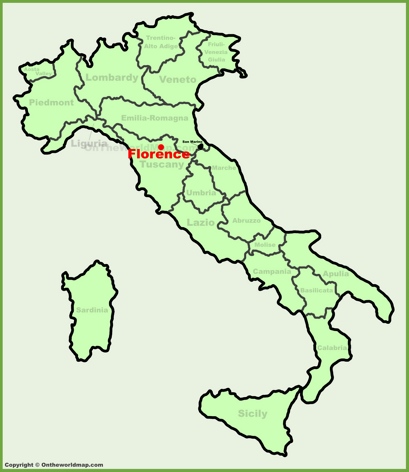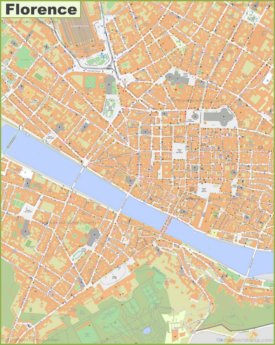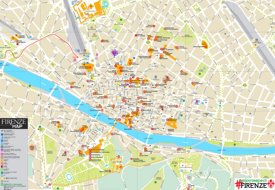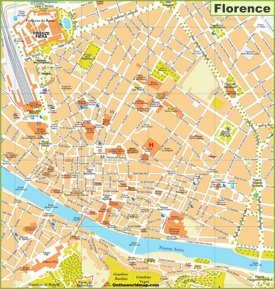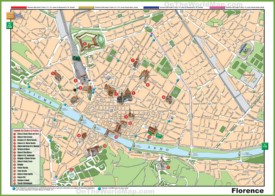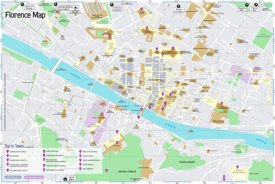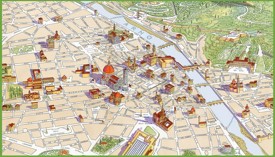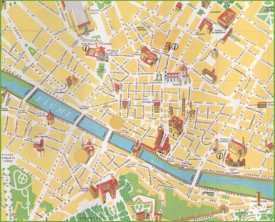Florence Maps
Online Map of Florence
About Florence (Firenze)
Florence, known as Firenze in Italian, is the capital city of the Tuscany region in central Italy. It is situated on the banks of the Arno River and is approximately 230 kilometers northwest of Rome. The city covers an area of about 102 square kilometers. As of the latest estimates, Florence has a population of 363,822 residents. The city is characterized by its blend of historical charm and modern urban life, attracting both locals and international visitors.
Florence is renowned for its rich history, particularly as the birthplace of the Renaissance during the 14th to 17th centuries. The city was a major cultural, economic, and political center under the rule of the powerful Medici family. Florence played a pivotal role in the development of art, architecture, and science, producing influential figures such as Leonardo da Vinci, Michelangelo, and Galileo Galilei.
Florence is celebrated for its architectural masterpieces and is a UNESCO World Heritage Site. Notable landmarks include:
Florence Cathedral (Cattedrale di Santa Maria del Fiore), commonly referred to as the Duomo, the Florence Cathedral is a masterpiece of Gothic architecture. Its construction began in 1296 and was completed in 1436 with the addition of the iconic dome designed by Filippo Brunelleschi. The cathedral is known for its intricate marble facade and impressive interior, which includes frescoes by Giorgio Vasari.



The Uffizi Gallery is one of the most prominent art museums in the world, renowned for its extensive collection of Renaissance art. Established in 1581, the museum houses works by masters such as Leonardo da Vinci, Michelangelo, Raphael, and Botticelli. The gallery is located in a historic building designed by Giorgio Vasari.

The Ponte Vecchio is a medieval stone bridge spanning the Arno River. It is famous for the shops built along it, which have traditionally been occupied by jewelers and goldsmiths. The bridge is one of the few remaining with shops and offers picturesque views of the river and city.

Palazzo Vecchio is the town hall of Florence, located in the Piazza della Signoria. Built in the 13th century, it is a striking example of Romanesque architecture. The building houses a museum with works by artists such as Donatello and Michelangelo. The tower offers panoramic views of the city.

Palazzo Pitti is the largestpalazzo in Florence, an outstanding monument of Quattrocento architecture. It is located in Piazza dei Pitti, on the left bank of the Arno River, connected by a “long corridor” across the river with Palazzo Vecchio. The Boboli Gardens, an outstanding monument of Mannerist garden art, adjoin the palace from the southeast.

The Boboli Gardens are a historic park located behind the Pitti Palace. Created in the 16th century, the gardens are a prime example of Italian garden design, featuring sculptures, fountains, and grottoes. The gardens offer a peaceful retreat and stunning views of Florence.


The Basilica of Santa Croce is a significant Franciscan church known as the Temple of the Italian Glories. It is the burial place of notable Italians, including Michelangelo, Galileo, and Machiavelli. The church features stunning frescoes by Giotto and a beautiful marble facade designed by Niccolò Matas.
The Accademia Gallery is best known for housing Michelangelo's David, one of the most famous sculptures in the world. The museum also contains other works by Michelangelo, as well as a collection of Renaissance paintings and sculptures.
The Basilica di San Lorenzo is one of the largest churches in Florence and a burial place for members of the Medici family. The church is notable for its unfinished facade and the New Sacristy, designed by Michelangelo. The interior includes works by Donatello and Brunelleschi.
Piazzale Michelangelo is a famous square offering panoramic views of Florence. It was designed in 1869 by architect Giuseppe Poggi as part of the city's redevelopment. The square features a bronze replica of Michelangelo's David and is a popular spot for tourists and locals alike.
The Bargello Museum is housed in a former barracks and prison, the Palazzo del Bargello. It contains a significant collection of Renaissance sculptures, including works by Donatello, Michelangelo, and Cellini. The museum also features decorative arts, such as ceramics, textiles, and weapons.
Orsanmichele is a church in Florence, an outstanding monument of Italian Proto-Renaissance art. The church is located in the city center between Piazza del Duomo and Piazza della Signoria with the Palazzo Vecchio building.

Santa Croce is a basilica in the center of Florence. One of the most popular tourist attractions of the city. The largest Franciscan church in the world, famous for frescoes by Giotto and tombs of great men of Italy.

Florence is a cultural epicenter, known for its contributions to art, literature, and music. The city hosts numerous cultural events and festivals, such as the Maggio Musicale Fiorentino, an annual opera and classical music festival. Florence's culinary scene is also notable, with traditional Tuscan dishes like ribollita, bistecca alla fiorentina, and cantuccini.
The economy of Florence is diverse, with significant contributions from tourism, manufacturing, and services. The city is a global fashion hub, home to many luxury brands and designers. Additionally, Florence has a strong industrial base, producing goods such as textiles, machinery, and pharmaceuticals. The city's vibrant tourism industry is driven by its rich cultural heritage and numerous historical sites.
The University of Florence is one of Italy's largest and most prestigious universities, offering a wide range of academic programs. The city is also home to several art and design schools, reflecting its historical and contemporary importance in these fields.
Florence is well-connected by various modes of transportation. The city has an efficient public transport system, including buses and a tram network. Florence's main railway station, Santa Maria Novella, provides high-speed train services to major Italian cities such as Rome, Milan, and Venice. The Florence Airport, Amerigo Vespucci, offers domestic and international flights.
The Facts:Region: Tuscany.
Province: Florence.
Area: 39 sq mi (102 sq km).
Population (2024): 363,822[1].
References
1. Demografia in cifre. Italian National Institute of Statistics.Maps of Italy
Cities of Italy
Cities of Italy
Regions of Italy

